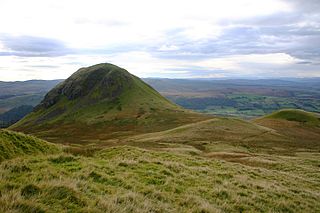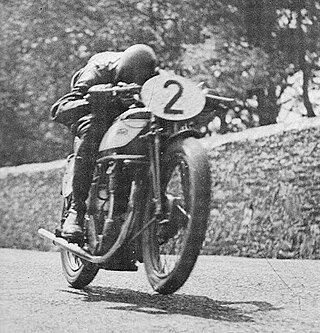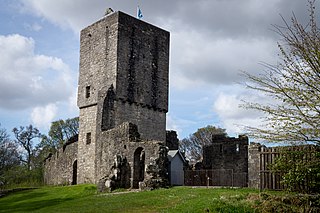
A furlong is a measure of distance in imperial units and United States customary units equal to one-eighth of a mile, equivalent to any of 660 feet, 220 yards, 40 rods, 10 chains or approximately 201 metres. It is now mostly confined to use in horse racing, where in many countries it is the standard measurement of race lengths, and agriculture, where it is used to measure rural field lengths and distances.

Stirlingshire or the County of Stirling is a historic county and registration county of Scotland. Its county town is Stirling.

The Stirling council area is one of the 32 council areas of Scotland, and has a population of about 92,530. It was created in 1975 as a lower-tier district within the Central region. The district covered parts of the historic counties of Stirlingshire and Perthshire, which were abolished for local government purposes. In 1996 the Central region was abolished and Stirling Council took over all local government functions within the area.

The Old Head of Kinsale is a headland near Kinsale, County Cork, Ireland.

Summerston is a residential area of Glasgow, Scotland. With most of the housing constructed in the 1970s, it is situated in the far north of the city and is considered to be part of the larger Maryhill district, but has a different postcode; other nearby neighbourhoods are Gilshochill to the south and Cadder to the south-east. With open farmland to the north-east, Summerston is separated from the southern parts of the town of Bearsden to the north-west by the River Kelvin and a golf course.

Dumgoyne is a hill prominent on the edge of the Campsie Fells and is a well-known landmark visible from Glasgow. It is a volcanic plug and is 427 m (1,401 ft) high. The plug is readily reached from a path beside Glengoyne Distillery or via a water-board track from the contiguous villages of Strathblane and Blanefield 3 miles to the east or Killearn to the west.
Commander Alexander "Alastair" Guthrie Denniston was a Scottish codebreaker in Room 40, deputy head of the Government Code and Cypher School (GC&CS) and hockey player. Denniston was appointed operational head of GC&CS in 1919 and remained so until February 1942.

Saint Blane was a bishop and confessor in Scotland, born on the Isle of Bute, date unknown; died 590. His feast is kept on 10 August.

Strathblane is a village and parish in the registration county of Stirling, situated in the southwestern part of the Stirling council area, in central Scotland. It lies at the foothills of the Campsie Fells and the Kilpatrick Hills on the Blane Water, 12 miles (19 km) north of Glasgow, 14 miles (23 km) east-southeast of Dumbarton, and 20 miles (32 km) southwest of Stirling. Strathblane is a dormitory village for Greater Glasgow, and has a total resident population of 1,811.

Torosay Castle is a large house situated 1+1⁄2 miles south of Craignure, in the parish of Torosay, on the Isle of Mull, in the Scottish Inner Hebrides.

James Guthrie was a Scottish motorcycle racer.

For the 1934 Isle of Man TT Races, despite the winning of four TT Races in two years, Stanley Woods parted with Norton motorcycles over the issue of prize money and race tactics and joined Husqvarna alongside Ernie Nott.

The Falls of Bruar are a series of waterfalls on the Bruar Water in Scotland, about 8 miles from Pitlochry in the council area of Perth and Kinross. They have been a tourist attraction since the 18th century and were immortalized in a poem by Robert Burns, The Humble Petition of Bruar Water to the Noble Duke of Atholl, supposedly from the river itself entreating the Duke to plant some trees in the then barren landscape.

Mugdock Castle was the stronghold of the Clan Graham from the middle of the 13th century. Its ruins are located in Mugdock Country Park, just west of the village of Mugdock in the parish of Strathblane. The castle is within the registration county of Stirlingshire, although it is only 2 kilometres (1.2 mi) north of Milngavie, East Dunbartonshire, on the northern outskirts of Greater Glasgow.

Haugh of Urr, is a village in the historical county of Kirkcudbrightshire in Dumfries and Galloway, Scotland. It is approximately 4 miles NNW of Dalbeattie, 3 mi (5 km) NE of Castle Douglas, 12+1⁄2 mi (20 km) west of Dumfries and 12+1⁄2 mi (20 km) east of Kirkcudbright.

Elphin is a crofting township in Assynt, in the Sutherland area of Highland in Scotland. It lies about 15 miles north of Ullapool. The village contains a telephone box, a post box, a tearoom, a Scottish Mountaineering Club Hut, Grampian Speleological Group Hut, a small caravan site and many self-catering options. Assynt Primary School closed in 2001, and the building is now a community hall operated by Elphin Ledmore and Knockan Community Association Limited. The township now has its own website, see external links.

The Giant Mountains, Krkonoše, or Karkonosze, are a mountain range located in the north of the Czech Republic and the south-west of Poland, part of the Sudetes mountain system. The Czech-Polish border, which divides the historic regions of Bohemia and Silesia, runs along the main ridge. The highest peak, Sněžka, is the Czech Republic's highest natural point with an elevation of 1,603 metres (5,259 ft).

Blanefield is a settlement in Scotland contiguous with Strathblane's northwestern fringe. To the west is the volcanic plug Dumgoyne, Glengoyne Distillery and the Trossachs National Park. The West Highland Way—a long-distance trail—passes close to the village.
Bardowie is a hamlet in East Dunbartonshire located within the civil parish of Baldernock. It is two miles from Milngavie and four miles from Strathblane. Along with other settlements in Baldernock, it was part of Stirlingshire until 1975, when Bardowie became part of the Strathclyde region. In 1996 another reorganisation placed Bardowie in East Dunbartonshire. The 1795 Richardson Thomas map of the town of Glasgow & country seven miles around refers to Bardowie as "Barduie".
William Smith of Carbeth Guthrie (1787–1871) was a 19th-century Scottish sugar trader who served as Lord Provost of Glasgow from 1822 to 1824.



















